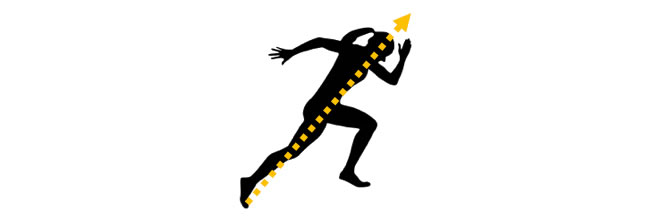|
Building Sprint Speed for Soccer Players By: Ken Vick Provided by: STACK
Sprinting has two main components: acceleration and maximum velocity. Acceleration is speeding up rapidly, and max velocity is sprinting over 75 percent of full speed. Since soccer sprints typically range from as little as 3 yards up to 39 yards, soccer players need both acceleration and max velocity. And, as performance coaches can tell you, the biomechanics and technique for each are distinctly different. Two clear differences you can see between acceleration sprint mechanics and max velocity sprint mechanics are body angle and leg action. Body Angle Draw an imaginary line from the foot contacting the ground through the center of mass (a few inches behind your navel). This is the Powerline. If the powerline is efficient, the line will be straight through the shoulders and head as well. During acceleration the angle is smaller, somewhere between 45 and 60 degrees from the ground, versus in max velocity sprinting, where the powerline is nearly vertical or 90 degrees from the ground.
Leg Action It's also easy, even for the untrained eye, to see the clear difference in the action of the legs. In max velocity mechanics, you use a cyclical action, with a "butt kick" and "step-over the knee." In acceleration, efficient mechanics are more of a "piston" action, with the knee punching forward and then driving backward.
Agility Although sprinting speed is very important, soccer isn't a track meet. It's not a linear game and elite players have great agility. Agility has two major components, Quickness and Change of Direction. Sprinting speed is great, but if you can't change direction, you're going to get burned. Quickness Lightning fast movements in 1 or 2 steps can make all the difference in reacting to an opponent or leaving one on the ground. These are the fakes and quick re-positioning movements that happen when you attack and defend throughout a game. Quickness requires the reactive strength to apply force to the ground quickly, and the body control/balance to make it efficient. Change of Direction The game isn't linear; players constantly change direction. As a player, the ability change direction faster and in fewer steps than the opposition gives you an edge. These are cases where you are already moving in one direction, then have to slam on the brakes and move a different way. To be efficient in change of direction, you need great eccentric strength abilities to decelerate, power to reaccelerate and proper movement mechanics to apply it at the right angle. Stability in the joints and core is also needed to ensure efficient transfer of energy and help prevent injuries. Formula for Speed
For all soccer movements, we have the Formula for Speed. Proven over decades by elite athletes and international & collegiate soccer players, this is the biomechanics of speed, simplified. The Big 4 constitute the Formula for Speed. No advanced degree in physics or neuroscience necessary. • Big Force That's what we coach. This formula has complexity underneath, but it‘s simple to apply and understand. It can also save you decades and help you achieve better results with your athletes. That's why I use it. Big Force You have to apply force to the ground to go somewhere. The faster you want to go, the more force you have to apply. Observing the difference in muscular development between a sprinter and a marathoner should give you a clue. This doesn't mean you only need to be bigger or become a powerlifter; but biomechanics research tells us that large forces have to be applied to move fast. The Big Force you need is developed by sprinting fast, using specific sprint and plyometric drills, and working in the weight room. We train six strength qualities, focusing on max strength, strength-speed, and speed-strength. Recommended Exercises: Box Blast, Sled March Small Time In sports, speed counts, so applying force in a small time while in contact with the ground is critical. You don't often hear an opponent saying, "Sure, take all the time you need to generate your force. I'll wait." Yes you need Big Force, but you also have to apply it to the ground in a (very) small time. This requires the right strength and motor control qualities. We develop those through technique drills that reinforce small ground contact time and through plyometrics and strength training drills that develop Rate of Force Development and reactive strength, instead of max strength or power. Recommended Exercises: Double Unders, Hurdle Hops Proper Direction Force has a direction as well as a quantity. Efficient and effective movement requires not just the right amount of force, but applying it in the right direction. Proper direction is achieved through the right motor pattern (technique) and stability of the body to apply it that way. When the structures of joints, muscles and tendons aren't up to the task, we have what we call "energy leaks." The motor control to create Proper Direction is developed through technical drills that teach athletes to move optimally. The stability to transfer those Big Forces comes through specific training drills. Recommended Exercises: Wall Drill, Harness Runs Optimal Range of Motion Goldilocks had it right: not too much, not too little, but just right. You need optimal range of motion in your joints, muscles and tendons. For some movements, you need large range of motion, and for others you need smaller. The key is that you are able to move without restriction or compensations. Many technical exercises and dynamic warm-up drills develop range of motion. In addition, we use mobility work such as self-myofascial release (foam rollers, balls, etc..) in conjunction with stretching techniques, or working with a tissue specialist. Recommended Exercises: Fast Leg, Arm Action Soccer-Specific Speed To play your best game, you need several kinds of speed. Players are usually better at one kind or another, but you can't afford any glaring holes. As an elite player, you need: • Acceleration You don't have to leave this to chance. You may need the right genetics to be fastest in the world, but through training, you can improve both your physical attributes and your motor control to get faster. Speed is a skill, and like any skill, it can be taught and learned.
|










